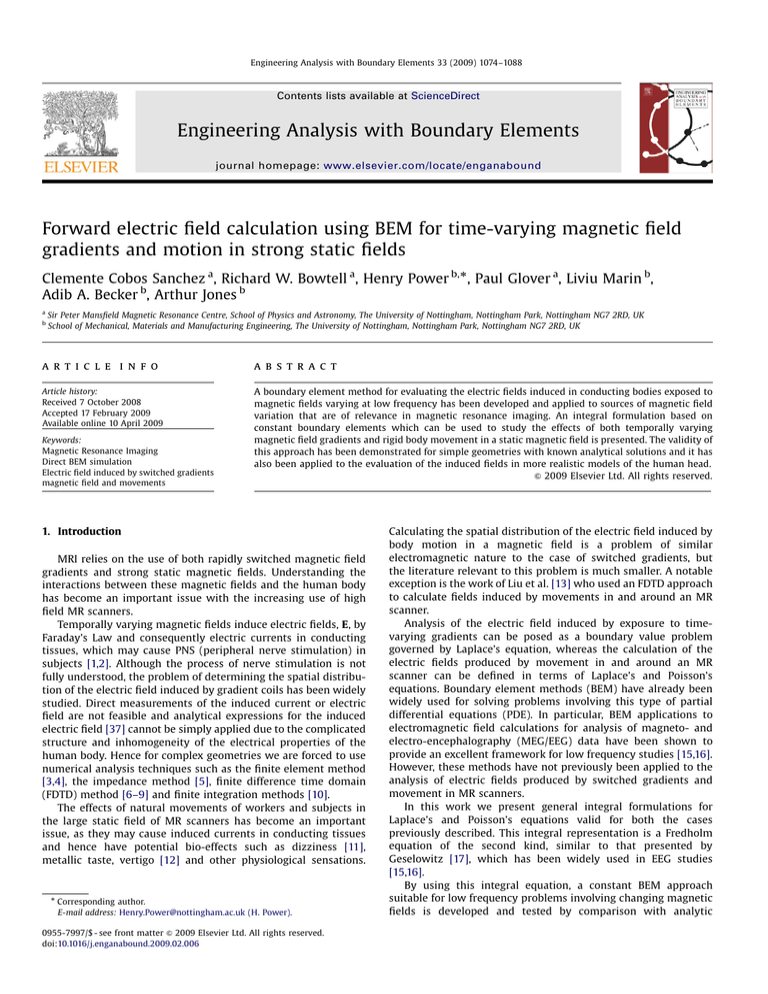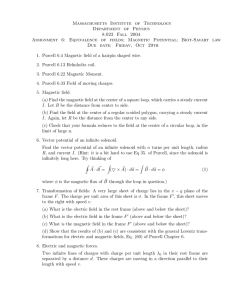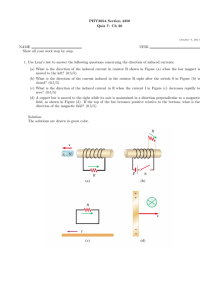
ARTICLE IN PRESS
Engineering Analysis with Boundary Elements 33 (2009) 1074–1088
Contents lists available at ScienceDirect
Engineering Analysis with Boundary Elements
journal homepage: www.elsevier.com/locate/enganabound
Forward electric field calculation using BEM for time-varying magnetic field
gradients and motion in strong static fields
Clemente Cobos Sanchez a, Richard W. Bowtell a, Henry Power b,, Paul Glover a, Liviu Marin b,
Adib A. Becker b, Arthur Jones b
a
b
Sir Peter Mansfield Magnetic Resonance Centre, School of Physics and Astronomy, The University of Nottingham, Nottingham Park, Nottingham NG7 2RD, UK
School of Mechanical, Materials and Manufacturing Engineering, The University of Nottingham, Nottingham Park, Nottingham NG7 2RD, UK
a r t i c l e in f o
a b s t r a c t
Article history:
Received 7 October 2008
Accepted 17 February 2009
Available online 10 April 2009
A boundary element method for evaluating the electric fields induced in conducting bodies exposed to
magnetic fields varying at low frequency has been developed and applied to sources of magnetic field
variation that are of relevance in magnetic resonance imaging. An integral formulation based on
constant boundary elements which can be used to study the effects of both temporally varying
magnetic field gradients and rigid body movement in a static magnetic field is presented. The validity of
this approach has been demonstrated for simple geometries with known analytical solutions and it has
also been applied to the evaluation of the induced fields in more realistic models of the human head.
& 2009 Elsevier Ltd. All rights reserved.
Keywords:
Magnetic Resonance Imaging
Direct BEM simulation
Electric field induced by switched gradients
magnetic field and movements
1. Introduction
MRI relies on the use of both rapidly switched magnetic field
gradients and strong static magnetic fields. Understanding the
interactions between these magnetic fields and the human body
has become an important issue with the increasing use of high
field MR scanners.
Temporally varying magnetic fields induce electric fields, E, by
Faraday’s Law and consequently electric currents in conducting
tissues, which may cause PNS (peripheral nerve stimulation) in
subjects [1,2]. Although the process of nerve stimulation is not
fully understood, the problem of determining the spatial distribution of the electric field induced by gradient coils has been widely
studied. Direct measurements of the induced current or electric
field are not feasible and analytical expressions for the induced
electric field [37] cannot be simply applied due to the complicated
structure and inhomogeneity of the electrical properties of the
human body. Hence for complex geometries we are forced to use
numerical analysis techniques such as the finite element method
[3,4], the impedance method [5], finite difference time domain
(FDTD) method [6–9] and finite integration methods [10].
The effects of natural movements of workers and subjects in
the large static field of MR scanners has become an important
issue, as they may cause induced currents in conducting tissues
and hence have potential bio-effects such as dizziness [11],
metallic taste, vertigo [12] and other physiological sensations.
Corresponding author.
E-mail address: Henry.Power@nottingham.ac.uk (H. Power).
0955-7997/$ - see front matter & 2009 Elsevier Ltd. All rights reserved.
doi:10.1016/j.enganabound.2009.02.006
Calculating the spatial distribution of the electric field induced by
body motion in a magnetic field is a problem of similar
electromagnetic nature to the case of switched gradients, but
the literature relevant to this problem is much smaller. A notable
exception is the work of Liu et al. [13] who used an FDTD approach
to calculate fields induced by movements in and around an MR
scanner.
Analysis of the electric field induced by exposure to timevarying gradients can be posed as a boundary value problem
governed by Laplace’s equation, whereas the calculation of the
electric fields produced by movement in and around an MR
scanner can be defined in terms of Laplace’s and Poisson’s
equations. Boundary element methods (BEM) have already been
widely used for solving problems involving this type of partial
differential equations (PDE). In particular, BEM applications to
electromagnetic field calculations for analysis of magneto- and
electro-encephalography (MEG/EEG) data have been shown to
provide an excellent framework for low frequency studies [15,16].
However, these methods have not previously been applied to the
analysis of electric fields produced by switched gradients and
movement in MR scanners.
In this work we present general integral formulations for
Laplace’s and Poisson’s equations valid for both the cases
previously described. This integral representation is a Fredholm
equation of the second kind, similar to that presented by
Geselowitz [17], which has been widely used in EEG studies
[15,16].
By using this integral equation, a constant BEM approach
suitable for low frequency problems involving changing magnetic
fields is developed and tested by comparison with analytic
ARTICLE IN PRESS
C.C. Sanchez et al. / Engineering Analysis with Boundary Elements 33 (2009) 1074–1088
solutions for simply shaped conductors, which are exposed to
switched gradients or moving in intense static fields.
The aim of this paper is to present a BEM for evaluating the
electric fields induced in conducting bodies by exposure to
switched gradients magnetic fields and movements in large static
fields. In Section 2, we present an electromagnetic theory for both
cases and as well as appropriate the boundary conditions valid for
the solution of both problems. In the following sections these
electromagnetic problems are described as integral equations,
which are solved using a constant BEM. Finally in Section 6, the
validity of this approach is demonstrated for simple geometries
with known analytical solutions and it is also applied to the
evaluation of the induced fields in more realistic and complicated
meshed models of the human body.
1075
where the vector potential defines the magnetic field via
B ¼ r A. The electric field can then be re-expressed as
~,
E ¼ r f þ A
(8)
2. Theory
such that it can be seen that there are two sources of E. The
~
computation of the second magnetic term is straightforward as A
is produced by current flowing in coils (main magnet or gradient)
whose wirepaths are generally known; whereas the conservative
term (generated by electric charges) cannot be simply evaluated,
and its calculation is the goal of our approach.
~ we obtain a general magnetic contribution to the
By defining A
electric field that allows us to maintain our original premise of
~
generating a BEM approach valid for all problems studied: A
becomes ioA for exposure to time-varying magnetic fields and
v B for movement at velocity v in a static field, B.
Using the approximation described in Eq. (2), it can be shown
that the scalar potential can be found by solving
2.1. Quasi-static limit
~ Þ.
rðsrfÞ ¼ rðsA
Gradient switching frequencies, o, for an MR scanner are
usually below 10 kHz and natural movements of the body lie in
the range 0–20 Hz. At these low frequencies, the electromagnetic
properties of the body allow us to use a quasi-static approximation, as has been discussed in [3] or [18]. This involves the
assumption that the induced current inside the conducting
system does not produce significant contribution to the magnetic
field, and that the ratio of displacement to conduction current is
very small
o
o103 ,
s
(1)
so that the displacement current can be neglected (where is the
electric permittivity and s the conductivity of the system) and the
current density, J ¼ sE, can be considered to be solenoidal, such
that
r J ¼ 0.
(2)
(9)
For regions with uniform conductivity this equation reduces to
Laplace’s equation for the case of time-varying magnetic field
gradients
r2 f ¼ 0,
(10)
since the magnetic vector potential is a divergence-free field, and
to Poisson’s equation
r2 f ¼ rðv BÞ ¼ r
,
e0
for movements in static magnetic fields, where e0 is the electric
permittivity of vacuum. In the latter case, the source term can be
identified as an electrostatic space charge, which is expected to be
present only when certain rotations [20] are considered
r ¼ e0 r E ¼ e0 rðv BÞ.
(12)
If we consider that the movement is composed of translation and
rotation
vðr; tÞ ¼ v0 ðtÞ þ XðtÞ r,
(13)
then
2.2. Maxwell’s equations
r ¼ e0 ½ðvðr BÞ 2X B,
In the case of a time-varying field we can adopt a sinusoidal
variation without loss of generality as any more complex waveform can be represented in terms of a Fourier superposition of
such modes [19]. Then for a non-magnetic system moving with
velocity v, Maxwell’s equations in the quasi-static regime can be
written as1
r B ¼ m0 J,
(3)
r B ¼ 0,
(4)
r E ¼ ioB þ r ðv BÞ,
(5)
r D ¼ rðrÞ,
(6)
where B is the magnetic induction or field, m0 the magnetic
permeability of the vacuum, rðrÞ the charge density and D the
electric displacement which is related to the electric field
according the constitutive equation D ¼ E.
We recall that the electric field can be written in terms of the
scalar, fðrÞ, and magnetic vector, A(r), potentials
E ¼ rf ioA þ v B
(11)
(7)
1
A rigorous account of the phenomena of conducting systems in movement
can be found in [20–23].
(14)
where X is the angular velocity.
In most practical cases, v m0 J5 2e0 X B, where r B ¼ m0 J,
given the low value of permeability m0, and hence
r ¼ 2e0 X B
(15)
2.3. Matching conditions
Let us consider a system composed of a set of homogenous
regions D1 ; . . . ; DM with constant conductivities s1 ; . . . ; sM , separated by interfaces S1 ; . . . ; SM with outward normal vectors to the
surfaces n; . . . ; nM and which is surrounded by air (sair ¼ 0), see
Fig. 1.
In order to obtain realistic solutions for our problem we use the
continuity of the current flowing at every surface between regions
as a matching condition between domains. This is a natural or
Neumann condition since the normal derivative of the potential is
specified.
This common requirement has been used previously in finiteelement simulations [24] (although as will be seen, we do not
consider the electric field to be continuous at the interface).
When imposing the conservation of the current density, J,
between two different domains at the separation surface we find
Ji ni ¼ Jiþ1 ni ) si Eni ¼ siþ1 Eniþ1 ,
(16)
ID
513239
Title
ForwardelectricfieldcalculationusingBEMfortime-varyingmagneticfieldgradientsandmotioninstrong
staticfields
http://fulltext.study/article/513239
http://FullText.Study
Pages
15







